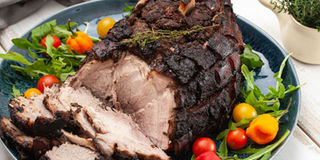Prime
Make a sumptuous Christmas meal

What you need to know:
Recipes. With reduced dining out options, you can give your family a gourmet Christmas meal at home. A Kadumukasa Kironde II shares delicious and easy to follow recipes.
Jamaican jerk pork tenderloin
Serves 8 – 10
Traditional Jamaican jerk would be made with a whole pig, boned and spread open like a book. Without the fiery jerk seasoning, it is imperative that you use Scotch Bonnet chilies which, fortunately, are readily available in the country. The traditional accompaniment to jerk pork would be Jamaican fry bread.
Method:
1. Butterfly the tenderloin and then using the paring knife, make holes a quarter inch deep all over each piece of meat. Place the tenderloin in a large non-reactive baking dish and set aside while you prepare the seasoning. Plan to marinate the meat for at least a minimum of four hours.
2. Combine the chilies, spring onions, onions, ginger and garlic in a food processor and twirl until finely chopped. Add the thyme, allspice, pepper, nutmeg, cinnamon, vinegar, soy sauce, salt and sugar (if you are using same) and process into a smooth puree.
3. Using a rubber spatula, spread the seasoning mixture over the meat, stuffing it into the holes. Cover and let marinade for at least four hours turning the meat several times.
4. If you are using a charcoal grill, then preheat to medium. If you are using a gas grill, then place the wood chips in the smoker box and preheat the grill to the high. When smoke appears lower the heat to medium.
5.When ready to cook, if using charcoal toss the wood chips on the coals and oil the grill grate. Arrange the sheets of pork on the hot grate and grill, turning with tongs and brushing occasionally with oil until nicely browned on both sides and cooked through allowing no more than 16 -20 minutes in all. When not turning the meat, keep the grill covered to hold in the smoke. You may also choose to use a conventional oven, in which case preheat the oven to 350dFH and bake 60 to 70 minutes to the kilo. When done, the internal temperature should be 185dFH.
6. Transfer the pork to a cutting board and let rest for five minutes and then cut into thin diagonal slices and serve at once.
Steamed dressed chicken luwombo
Serves 8-10
Ingredients:
2 whole range chickens, preferably female
1.5 kg (3.3 pounds) tomatoes
6 tbsp tomato paste
6 cloves crushed garlic
12-14 finely chopped shallots
Salt and pepper to taste
Luwombo leaves
4-6 diced Irish potatoes
Banana leaves
Cooking oil
4-6 tbsp margarine
1 litre of chicken stock plus
Banana peel
2 bay leaves
2 chopped onions
Method:
1.Have ready a charcoal stove or a barbecue grill that is alight but fiery hot. The charcoal embers should be barely glowing and spread some of the banana peels over it and then grill the chickens (whole) until they become a nice golden brown. When done, remove and set aside leaving them whole.
2.In the meantime, drop the tomatoes in some boiling water and allow them to boil for a few minutes, and remove the skin and mash them with your fingers until they become coarsely pulverized. Heat a little cooking oil and add the chopped shallots and gently fry them until they become translucent. Add the garlic (leave two teaspoons for later use) and continue frying for a couple of minutes before adding two thirds of the tomatoes and four tablespoons of the tomato paste.
3. Cook over low heat and allow to gently simmer. Add some salt and pepper, the margarine and the bay leaf as well as some chicken stock.
4. Peel the Irish potatoes and quarter them and set them aside for later use. Heat some of the oil and add the chopped onions and fry them over low heat until they become translucent. Add the garlic and fry for another couple of minutes before adding the remaining tomatoes, tomato paste and salt and pepper.
5. Add the chopped potatoes and bring to a boil and simmer gently covered for about ten minutes.
6.When you are ready to cook the luwombo, stuff the two chickens with the potatoes and truss them with a piece of string or what we call a kyai and then get hold of a kibbo or a small shallow bowl that is large enough to accommodate one chicken.
7. Place the luwombo leaf into a small kibbo or bowl, the leaf ought to have an inner leaf and then place the chicken inside the leaf with the leaf forming a cup-like effect and make certain that the drumsticks are facing up and spoon about a third of the sauce into the luwombo leaf.

8. Hold the both ends of the banana leaf and fold it together and then carefully tie the leaf with a string or kyai being careful not to pierce the luwombo leaf.
9. Place the chicken luwombos in a large saucepan that has been lined with a few stems from a bunch of matooke. Otherwise, invert a perforated metal strainer or a colander that will enable the chickens to comfortably be placed while they are being steamed.
10. It is important that you see to it that the saucepan is large enough to accommodate both chickens or else steam them separately. Tuck in some banana leaves over the mpombo’s and steam over low heat until the chicken is tender. Allow at least two hours or if you are using broiler chickens then they should be done within less than an hour.
Tropical fruit salad
Serves about 6
Ingredients:
1 good size pineapple
400g guava halves in syrup
4 sukali ndizi bananas
4 tbsp coconut milk
1 large mango peeled and cored
½ tsp nutmeg
115g stem ginger & tbsp syrup
½ tsp ground cinnamon
Strips of coconut for garnishing
1 small paw paw
1 small melon cubed
Method:
1. Peel and core then cut the
pineapple
into cubes and place in a serving bowl.
2. Drain the guavas and reserve the syrup then add them to the bowl with a couple of the bananas, paw paw, melon and the mango. Chop the stem ginger and add it to the pineapple mixture.
3. Measure a ½ tbsp of the ginger syrup along with the reserved guava syrup and put it into a food processor then add the remaining two bananas with the coconut milk and the sugar then puree into a smooth cream.
4. When ready to serve pour the banana and coconut mixture over the fruit and sprinkle over the fruit. Serve well chilled.
Ingredients:
2 kg pork tenderloin (6 to 8 tenderloins). Admittedly, these may be costly and difficult to come by in which case I recommend that you use boneless pork sirloin. If that fails, then have the butcher debone a couple of legs of pork and you are good to go.
4 to 20 Scotch Bonnet chilies (for a milder jerk, seed the chilies)
4 bunches spring onions, both white and green parts, trimmed and cut into 1-inch pieces
2 medium size onions, cut into 1-inch slices
2 pieces (1-inch) fresh ginger, thinly sliced
6 cloves good size garlic, peeled
2 tablespoons fresh thyme or 4 teaspoons dried
5 teaspoons ground allspice
1 teaspoon freshly ground black pepper
1 teaspoon freshly grated nutmeg
½ teaspoon ground cinnamon
½ cup distilled vinegar
6 tablespoons light soy sauce
4 tablespoons vegetable oil
6 tablespoons salt
2 tablespoons firmly packed light brown sugar (optional)
2-4 tablespoons of vegetable oil, for basting




